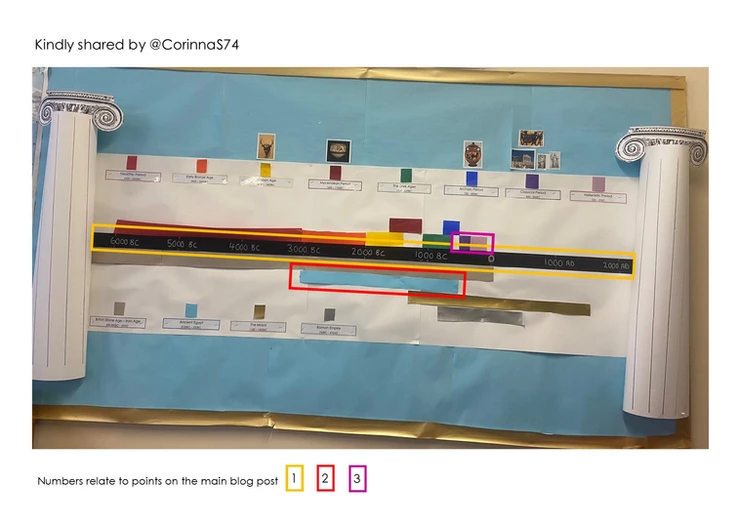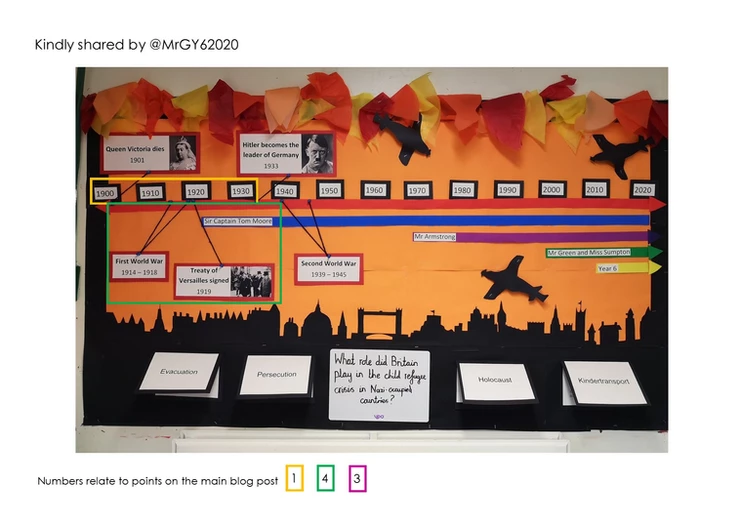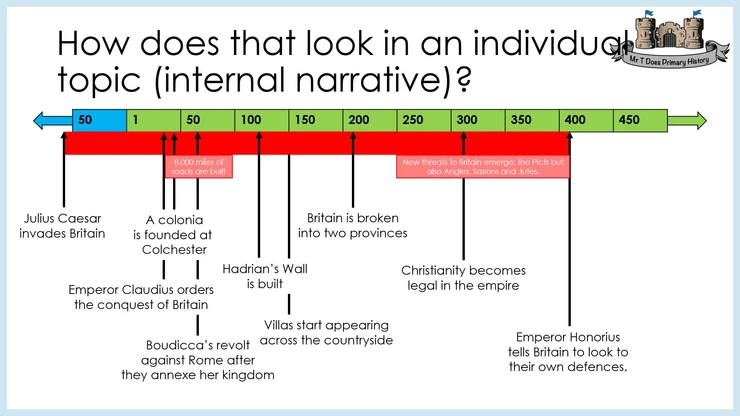Setting the scene:
Chronology is a dominant feature of the primary National Curriculum for history (NC2014). There is a clear link from Ofsted’s report ‘History for All’ in 2011 to the NC2014 (let’s ignore the monstrosity that was draft 1 shall we!). A couple of key phrases stand out: “Although pupils in primary schools generally had good knowledge of particular topics and episodes in history, their chronological understanding and their ability to make links across the knowledge they had gained were weaker.” (p5) This, anecdotally, is something many schools that I work with say is a difficulty for their children. A recommendation from History for All was that: “…pupils in primary schools experience history as a coherent subject which develops their knowledge, thinking and understanding, especially their chronological understanding,” (p7). The influence of this is evident across the curriculum’s purpose of study, aims and subject content. If you haven’t already read them, make sure you do because they explain so much more about how we teach history and the breadth beyond toys, Romans or the Great Fire of London.
How it impacted my teaching of chronology:
Teaching it in two clear ways: the overall narrative or wider history to reinforce how the timelines fit together to form the ‘complete’ narrative. This and the internal narrative of each period of history which is more detailed and sets out the narrative to be taught across that half-term. This was influenced by the glorious work of Ian Dawson who said at the first Northern History Forum (now called the Yorkshire History Forum) to use the language of story when teaching chronology. He used the words to the effect of, “We are learning the story of the Romans. We don’t have time to learn the full story and will only get chance to look at a couple of phrases.” As I now know, this uses the same principles as Willingham showing that the human brain privileges story. The implication for my teaching is that I use narrative extensively as an idea within history… I mean, the word is right there!
Ensuring chronology is just not just a quick tick box activity completed once at the start of the topic to tick that objective off the progression of skills spreadsheet (DON’T get me started on assessment spreadsheets for primary foundation subjects). But rather a fundamental part of the teaching sequence for adding new, linking to existing and reinforcing the core knowledge associated with the enquiry question. “Chronology is a key organising tool for developing pupils’ understanding of history and as a ‘concept’ within the history curriculum.” (Phillips, 2008 cited here) From this, we can conclude that ‘chronology’ is an ongoing process in students learning of history and plays an important role in the both the teaching and learning of history. This is not something I was aware of when I started teaching.
Finally, teaching children how to interpret the timelines had to be a fundamental building block during lessons alongside the substantive knowledge which they presented. There is such a direct link to maths and therefore it was helpful to consider the presentation and complexity of the data. I’ve annotated two of the display pictures I was tagged in (with kind permission from the teachers) to explain this below.
Materials to use:
If you ever have to endure CPD from me around chronology, you’ll come to know my love of using border paper for timeline construction – it’s the perfect material and schools have it in abundance! All of the following points can be done with border paper and either on the floor for more active engagement and exploration or as a display on the wall to refer to and build on. I am absolutely aware that schools use toilet paper for the same purpose, using each sheet as an increment on the scale but, personal preference sends me to border paper.
Building the timeline:
I will always advocate for building BIIIIIIG timelines and ensuring children have chance to interact with them to fully engage with the information it presents. This blog by my great mentor in all things history (@historyprimary) sums it up. The approach mirrors the annotations of the timeline display so should hopefully help:

1) Numbered scale – by adding a numbered scale, we can make our timelines more precise, easier to construct and interpret. A common pitfall is the labelling of year 0. Because of the way we count centuries, there is no year 0 and we move from 1 BC/BCE to AD/CE 1. The clear and precise scale is a requirement for the subsequent points to work. For the majority of primary classes, I construct and label the scale so the focus is on the timeline bars and making the links between them. The exception was a Year 6 class who I had built timelines with before. They were really familiar with the process so it was a step for them to take control over. We built the timeline across the hall and used post-its labelled with centuries as markers. I always put an arrow on my scale to indicate time expands far further into the past than we could every show on a display/in a lesson. It also forms a key teaching point to ensure the enormous duration of the Palaeolithic isn’t misunderstood.
2) Periodisation, intervals and duration – We teach periods of history across Key Stage 2. This is a core concept to cover when we introduce history to Year 3. The fact that we are studying history across hundreds or potentially even millions of years makes and including the lives of a range of people, a multitude of events etc makes it a more challenging concept than in Key Stage 1. To that end, the overall narrative timeline shows simple bars to ensure the focus is on the narrative. The differing duration is simpler to identify because of the accurate scale and bar sizes (similar to a bar model/graph in maths). For British history, where the periods that we teach flow naturally, children can identify that there may be intervals between periods (end of Roman Britain in 410 AD to the alleged arrival of Hengist and Horsa in AD 450).
3) Relative position on the overall narrative – When teaching the achievements of Ancient Greece, we mainly focus on the classical period. This is a smaller part of the narrative of the history of Greece so appears with a small duration on the timeline. We can then have a second timeline with a much smaller scale to interpret that period of time with more precision and depth. The principle is that we can highlight the overall narrative before ‘zooming in’ on one smaller part. I use the phrase zooming in as the children are familiar with the action on iPads etc. If you really must, you can even have a gimmicked sound or action… not for me mind you!
4) Bars for periods or a duration of time and arrows for single events or ‘points’ – this was something that took me a couple of attempts to get right when teaching the internal narrative. I was used to building the timelines, talking about periodisation, duration and intervals but the display didn’t really represent them effectively enough. I tried arrows for start and end points but didn’t feel the connection was strong enough. As such, the arrow for points and bars for duration become my choice. It allows me to distinguish between a singular event and a change over time. This links to the accompanying disciplinary understanding of continuity and change.
For example:
– I’d mark Boudicca’s revolt in AD60 – 61 as a point (marked with an arrow) because it’s a short duration of time and, in effect, one point on the overall timeline even though it covers more than one year.
– the construction of around 8,000 miles of road would be a bar because it was a change that took place across the first 60 years or so of the period. It’s also an effective way of summarising a group of linked events. On the second example shown, it’s harder to see the duration of the First World war with two strings when it’s so close to the Treaty of Versailles being signed.

5) Link between British and world history using the scale to support – one of the most important NC2014 aims is number 6 which is located on a different page to the other 5 so could easily be missed. It states: “gain historical perspective by placing their growing knowledge into different contexts, understanding the connections between local, regional, national and international history; between cultural, economic, military, political, religious and social history; and between short- and long-term timescales.” Because of this, I always depict British and world history separately to ensure the concurrence is clear and make the connections can be established clearly. A natural boundary would be the scale and having British history above and world history below. Then, as the overall narrative is constructed, the concurrent periods can be established, discussed and any interactions considered. Although not literally related to the timeline display, having a world map established to make those links is an absolute must. The two disciplines are absolutely linked when establishing the links between British and world history.
What to include on the overall narrative?
What should I put on my overall narrative is an important question to consider? It depends on a number of variables so the decision is more nuanced than choice a or b (that’s surely the narrative of teaching history…) so this hopefully covers a range of options. For any approach, it’s important to consider how to reinforce which periods of history interacted. The way in which I show this is with an overlap. In Key Stage 2, these would be:
– The British iron age and Roman Britain period
– The Anglo-Saxon and Viking conflict
– The expansion of the Roman empire, Ancient Egypt and Ancient Greece
– The Viking trade contact with the Abbasid Caliphate (Early Islamic history)
A whole school chronology display – in this case, it needs to represent everything that’s taught across Key Stage 2 history. The teaching would focus on which periods of history the children are already aware of and linking them to the knew knowledge taught.
A timeline in each class (my preferred option) – here, we can limit the amount of information based on what is taught. I would suggest having the LKS2 curriculum in both Year 3 and 4 to begin to build the narrative. The complete curriculum would be displayed in UKS2. The teaching in Year 3 would focus on establishing what a period of history is and how they form a narrative. Making links between what was taught in Year 3 and the continued narrative in 4. My logic here is based upon the fact that only having two history periods taught would result in a largely empty timeline and therefore harder to introduce the concept of periodisation and how the periods form the narrative. Year 4 could then add further depth and ensure links are established and reinforced. I would also consider what information must be presented on the overall narrative so as to reduce the unnecessary cognitive load on children. On the overall narrative, my preference is just the periods of history.
What to include on the internal narrative?
The purpose of my timelines of the internal narrative is to set out the context of what is to be taught during the subsequent enquiry/enquiries. It is representing a much smaller duration of time than the overall narrative and can be more detailed to show specific events, people etc. Using the timeline as an organisational tool helps to make those important links because the information is presented in context.
Once again, the key people, events and changes to be taught are what I would place on the timeline. If you aren’t teaching about something, why is it on your timeline? I’ve included a screenshot of a PPT example where all of the content ties directly to the taught lessons in history or the wider curriculum. The visual depiction allows me to break the Roman Britain period into three phases. First, the actual invasions, conquest and gaining control (although there were rebellions and raids throughout the period). Then, during the consolidation of control with Hadrian’s Wall being built alongside villas etc being built. Finally, post 250AD, the raids from the Picts et al was a feature of the weakening grip Rome had on its empire at large.

The chronology display as part of the teaching sequence
Every time a lesson is taught, the position on the internal narrative is reinforced and linked to what the children already know. If there’s a substantive link between this and a previous period studied, this can explored using the overall narrative timeline. If your school uses a working wall approach to displays, greater depth of information can be added with annotated pieces of work, collaborative tasks etc.
Hopefully what came from this blog is an urge to teach more chronology! – Teach it explicitly at the start of topics, reinforce the overall narrative and where the new period sits.
– Add introductory context by constructing the internal narrative. Be mindful to put key facts on and not overdo it!
– Reinforce the internal narrative throughout each topic and make links where appropriate.
– The importance with teaching history with a sense of narrative. The overall narrative to show how the periods of history we teach fit together, flow concurrently and how civilisations interacted with each other.
– Understanding the composite parts of a timeline so it’s more than just a random sequence with no context.
Bibliography:
https://www.aft.org/periodical/american-educator/summer-2004/ask-cognitive-scientist
https://www.teachprimary.com/learning_resources/view/how-to-teach-chronology-in-ks1-ks2
https://www.history.org.uk/primary/resource/4100/how-to-teach-chronology
https://discovery.ucl.ac.uk/id/eprint/10118307/1/What-Should-Schools-Teach.pdf
http://eprints.glos.ac.uk/7775/1/7775%20Butler%20%282017%29%20Chronological%20Understanding.pdf
https://teacherhead.com/2014/02/16/teaching-the-timeline-chronology-as-core-curriculum/
Books:
Understanding and Teaching Primary History by James Percival pp34 – 53 in particular
Mastering Primary History by Karin Doull, Christopher Russell and Alison Hales
